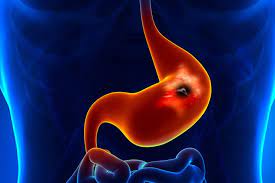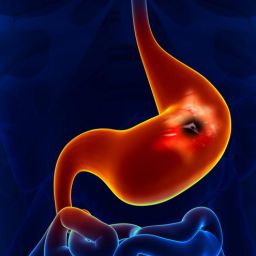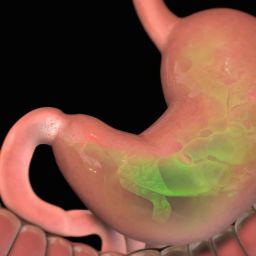
1. Understanding Ulcers: An Overview
Before diving into the age-related risks of ulcers, it is important to understand what ulcers are and how they form. Ulcers are typically classified into two types based on their location:
- Gastric Ulcers: These ulcers occur in the stomach lining and are typically caused by the breakdown of the mucosal barrier that protects the stomach from acidic digestive juices.
- Duodenal Ulcers: These ulcers occur in the first part of the small intestine (the duodenum) and are also related to the damage caused by stomach acid.
- Esophageal Ulcers: These occur in the lining of the esophagus, often due to acid reflux or gastroesophageal reflux disease (GERD).
The primary causes of ulcers are:
- Helicobacter pylori (H. pylori) infection: A type of bacteria that can weaken the protective mucus layer of the stomach.
- Nonsteroidal anti-inflammatory drugs (NSAIDs): Long-term use of these medications can cause damage to the stomach lining.
- Excessive alcohol consumption: This can irritate the stomach lining, increasing the risk of ulcer formation.
- Stress and poor diet: While these are not direct causes, they can exacerbate the condition and make the stomach more vulnerable to damage.
With that background, let’s now look at how age plays a role in the development of ulcers.
2. Age Groups at Higher Risk for Ulcers
1. Older Adults (65 years and above)
Among all age groups, older adults, especially those aged 65 and above, are at the highest risk for developing ulcers. Several factors contribute to this increased vulnerability:
Age-Related Changes in the Stomach Lining
As people age, the stomach’s ability to produce mucus and bicarbonate, which protect the stomach lining, decreases. This makes the stomach more susceptible to damage from gastric acid and other irritants.
Medications

Older adults are more likely to take medications, including NSAIDs (like aspirin, ibuprofen, and naproxen) for chronic pain, arthritis, or other conditions. Long-term use of NSAIDs is a significant risk factor for developing ulcers, as they reduce the stomach’s ability to protect itself from digestive acids.
Additionally, the use of blood thinners and steroid medications is common in older adults, both of which can increase the likelihood of ulcer formation or worsen existing ulcers.
Helicobacter pylori Infection
H. pylori infection is also more prevalent in older adults, contributing to the increased risk of ulcers. The bacteria thrive in the stomach lining, causing inflammation and weakening the protective layer, making it easier for ulcers to develop.
Decreased Blood Flow
Aged individuals may experience reduced blood flow to the stomach due to factors like cardiovascular diseases. This limited circulation can impair the stomach’s ability to repair itself after injury or inflammation, contributing to the formation of ulcers.
Symptoms in Older Adults
In older adults, ulcer symptoms may be less obvious, and they might experience complications like perforation or bleeding without significant warning signs. This makes early detection and treatment more challenging.
2. Middle-Aged Adults (40-64 years)
Middle-aged adults are also at an elevated risk for ulcers, although they are less likely to experience complications than older adults. Here are the factors contributing to the increased risk in this group:
H. pylori Infection
H. pylori infections are most commonly acquired during childhood, but they can become symptomatic in middle age. As the infection progresses, it weakens the stomach lining, leading to ulcer formation.
Stress and Lifestyle Factors
Middle-aged individuals often experience high levels of stress due to work, family responsibilities, or financial pressures. Chronic stress can increase stomach acid production, aggravating an existing ulcer or increasing the risk of ulcer formation.
Dietary habits and lifestyle choices, such as excessive alcohol consumption, smoking, and irregular meal patterns, can also contribute to the development of ulcers in this age group. These habits can irritate the stomach lining, causing or exacerbating ulcer symptoms.
Medications and Overuse of NSAIDs
Many middle-aged adults take NSAIDs regularly for conditions like joint pain, headaches, or back pain. Regular use of these medications increases the risk of ulcer formation, especially when combined with other risk factors like smoking or alcohol use.
Gastroesophageal Reflux Disease (GERD)
Another contributing factor to ulcer development in middle-aged adults is GERD, a condition that causes acid reflux. The continuous irritation of the esophagus and stomach lining by stomach acid can increase the likelihood of developing ulcers.
3. Younger Adults (18-39 years)
While ulcers are less common in younger adults, they still can develop, particularly in individuals who have specific risk factors. The primary risks for ulcer formation in this group are:

Helicobacter pylori Infection
H. pylori infection is a leading cause of ulcers in younger adults. If left untreated, the bacteria can cause chronic inflammation, leading to ulcer formation. The infection is often asymptomatic for years before ulcer symptoms develop.
Lifestyle Factors
Certain lifestyle factors, such as smoking, poor diet (particularly high-fat or spicy foods), and excessive alcohol consumption, can contribute to the development of ulcers in younger adults. Additionally, the use of NSAIDs for pain relief is also common in this age group and can increase the risk of ulcers.
Stress and Mental Health
Chronic stress, anxiety, and depression are more common in younger adults and can have a negative impact on gastrointestinal health. These conditions can increase stomach acid production and make the stomach lining more vulnerable to damage, contributing to ulcer formation.
4. Adolescents and Children
While much rarer, ulcers can also occur in adolescents and children. The primary causes of ulcers in this age group include:
Helicobacter pylori Infection
Just like in adults, H. pylori infection can cause ulcers in children and adolescents. This infection may be passed from person to person, and in children with poor hygiene or those living in crowded conditions, the bacteria can lead to stomach ulcers.
Genetic Predisposition
There is some evidence to suggest that a genetic predisposition may make certain children and adolescents more susceptible to developing ulcers. Family history can be a contributing factor.
Medications
Some children, especially those with chronic conditions or injuries, may be prescribed NSAIDs, which can lead to ulcers. Additionally, children taking steroids or undergoing chemotherapy may be at an increased risk for developing ulcers due to the impact of these medications on the stomach lining.
3. Risk Factors That Increase Ulcer Susceptibility
While age plays a significant role in ulcer development, there are several other factors that can increase an individual’s risk of developing ulcers, regardless of their age group:
1. Helicobacter pylori Infection
This bacterial infection is the primary cause of ulcers worldwide. It weakens the stomach’s protective lining, making it more susceptible to damage from gastric acid. Anyone, regardless of age, who is infected with H. pylori is at risk for developing ulcers.
2. Nonsteroidal Anti-inflammatory Drugs (NSAIDs)
Frequent or long-term use of NSAIDs can irritate the stomach lining and increase the risk of ulcers. People of all ages who regularly use these medications for pain relief should be aware of the potential risks.
3. Smoking
Smoking reduces the stomach’s ability to produce protective mucus, increasing the risk of ulcers. Smokers are more likely to develop ulcers and experience complications like bleeding.
4. Excessive Alcohol Consumption
Excessive drinking can irritate and inflame the stomach lining, which increases the risk of ulcers.
4. Prevention and Management of Ulcers
Regardless of age, ulcers can often be prevented or managed with the right lifestyle changes and medical treatments. Here are some key strategies:
- Avoiding NSAIDs: If possible, limit the use of NSAIDs and opt for safer alternatives for pain management.
- Eradicating H. pylori: If you have an H. pylori infection, a course of antibiotics prescribed by your doctor can help clear the bacteria and prevent ulcer development.
- Healthy Diet: Eating a balanced diet rich in fiber and low in fatty and spicy foods can help protect the stomach lining.
- Stress Management: Practicing relaxation techniques like meditation, yoga, or deep breathing exercises can help reduce stress and prevent ulcers from developing.
- Quitting Smoking: Stopping smoking can significantly reduce the risk of ulcer development and promote healing of existing ulcers.
- Limiting Alcohol: Moderating alcohol consumption can help protect the stomach lining from damage.
Ulcers are a common gastrointestinal condition, and their risk varies depending on factors such as age, lifestyle, and underlying health conditions. While older adults and middle-aged individuals are more likely to develop ulcers due to factors like medication use, H. pylori infection, and lifestyle choices, younger adults and children can also be affected, particularly if they have specific risk factors.



